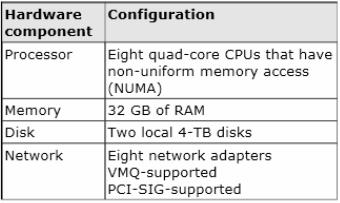Microsoft Exam 70-410 Topic 13 Question 2 Discussion
Topic #: 13
Your network contains a server named Server1 that runs Windows Server 2012 R2. Server1 has the Hyper-V server role installed.
Server1 hosts four virtual machines named VM1, VM2, VM3, and VM4.
Server1 is configured as shown in the following table.

VM2 sends and receives large amounts of data over the network.
You need to ensure that the network traffic of VM2 bypasses the virtual switches of the parent partition.
What should you configure?
Single-root I/O virtualization -capable network adapters can be assigned directly to a virtual machine to maximize network throughput while minimizing network latency and the CPU overhead required for processing network traffic.
References: http://technet.microsoft.com/en-us/library/cc766320(v=ws.10).aspx
http://technet.microsoft.com/en-us/library/hh831410.aspx
Exam Ref 70-410, Installing and Configuring Windows Server 2012 R2, Chapter 3: Configure Hyper-V, Objective 3.1: Create and Configure virtual machine settings, p.144
Training Guide: Installing and Configuring Windows Server 2012 R2: Chapter 7: Hyper-V Virtualization, Lesson 2: Deploying and configuring virtual machines, p.335
Currently there are no comments in this discussion, be the first to comment!